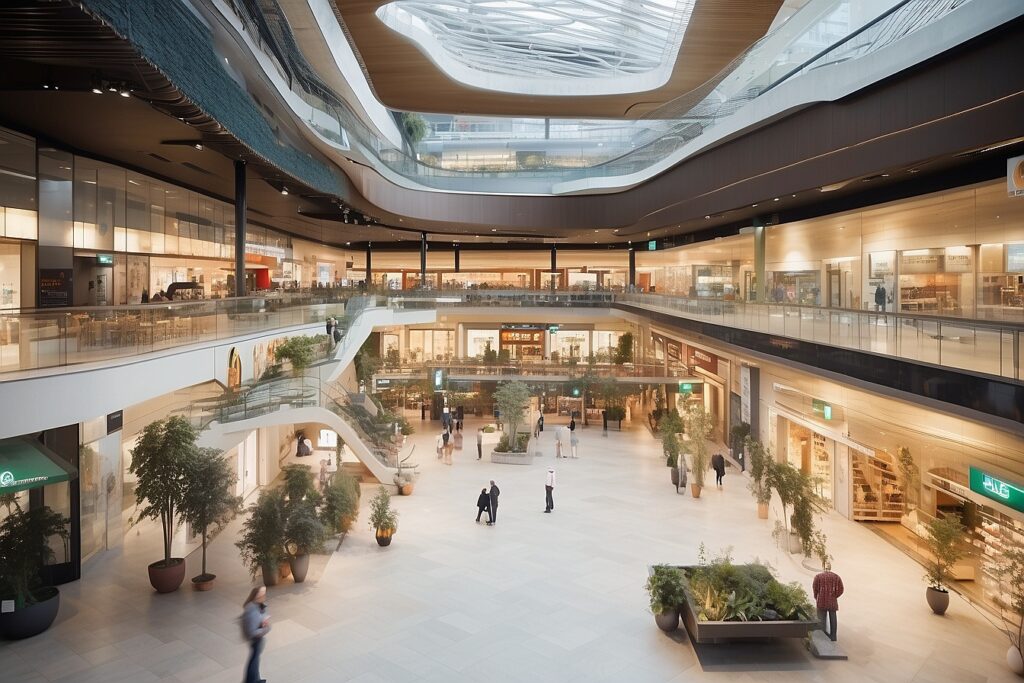Sustaining the Polish Shopping Centre Market: A Deep Dive into Energy Efficiency Measures

The Polish shopping center landscape has evolved significantly since the 1990s and 2000s when many of these retail hubs were constructed. Back then, considerations for energy efficiency were not as prevalent, and the technological advancements we see today were not yet fully realized.
Now, faced with the imperative of reducing energy consumption and addressing environmental concerns, a wave of upgrades is on the horizon for these mature shopping centers. However, this transformation won’t occur overnight due to the substantial refurbishment investments required.
Experts from Cushman & Wakefield, overseeing a diverse portfolio of shopping centers and retail parks, offer valuable insights into the innovative and cost-effective measures being implemented to tackle the rising challenges of energy and heat consumption. Despite their age, shopping centers from the late 20th and early 21st centuries remain popular destinations, benefiting from prime locations, strong brand recognition, and connectivity.
Yet, they must adapt to evolving consumer expectations and regulatory demands regarding energy efficiency.
The surge in energy prices over the past two years, with growth reaching several hundred percent, has intensified the urgency to find immediate cost-saving solutions. Shopping centers under Cushman & Wakefield’s management are exploring various options, including investing in renewable energy sources such as photovoltaic panel systems.
Elżbieta Marchut, Director of the Ster Shopping Centre in Szczecin, highlights the importance of initiatives like replacing traditional lighting with energy-efficient LEDs, which can result in electricity savings of up to 50%.
The push for energy efficiency isn’t solely driven by regulatory requirements, such as the EU’s legislation on energy performance certificates; it’s also a response to escalating operational costs. Property managers and retail landlords recognize the need to balance economic sustainability with environmental responsibility. Retrofitting older shopping centers with energy-efficient technologies not only reduces carbon footprints but also enhances cost-effectiveness in the long term.
While the transition to greener practices is imperative, it presents a significant financial challenge. Retrofitting existing infrastructure requires substantial capital investment, posing a hurdle for many shopping center operators. However, the long-term benefits in terms of reduced energy bills and enhanced sustainability make it a worthwhile endeavor.
Moreover, there’s growing pressure from consumers and investors for businesses to demonstrate their commitment to environmental stewardship.
In addition to energy-efficient upgrades, shopping centers are exploring other avenues to enhance sustainability. Waste management programs, water conservation initiatives, and the promotion of eco-friendly practices among tenants and visitors are becoming integral parts of their strategies. These efforts not only contribute to reducing environmental impact but also foster a sense of community engagement and responsibility.
Furthermore, technology plays a pivotal role in optimizing energy consumption and improving overall operational efficiency. Smart building systems, IoT sensors, and data analytics enable shopping center operators to monitor energy usage in real-time, identify areas for improvement, and implement targeted interventions. These technological innovations empower decision-makers to make informed choices that drive sustainability goals while maximizing cost savings.
Collaboration across the industry is also crucial in driving sustainable transformation. Knowledge sharing, best practices exchange, and collective initiatives can accelerate progress towards a more environmentally conscious retail sector. Partnerships with energy suppliers, technology providers, and sustainability experts offer valuable resources and expertise to navigate the complexities of green transitions effectively.
In conclusion, the Polish shopping center market stands at a pivotal moment in its evolution, where the imperative of energy efficiency intersects with the need for economic sustainability. While the challenges are significant, the commitment to greener practices presents opportunities for innovation, collaboration, and long-term viability. By embracing sustainable initiatives, shopping centers can not only reduce their environmental footprint but also enhance their competitiveness and resilience in an evolving market landscape.
Harnessing Solar Power and Efficient Lighting Revolutionize Energy Consumption in Public Spaces
Innovative solutions are transforming the landscape of energy consumption in communal areas, with photovoltaic panel systems emerging as a pivotal player. Rooftops and elevations adorned with these systems boast the potential to cater to approximately 10% of energy needs within these spaces. Moreover, the integration of solar canopies in designated car park areas presents yet another avenue to bolster energy sustainability.
Beyond the realm of solar power, the adoption of Light Emitting Diodes (LEDs) stands as a beacon of efficiency in communal spaces, particularly within shopping centers.
These advanced lighting systems not only curtail electricity consumption but also rectify design flaws, enhancing both the color rendering and intensity of light. The shift towards LEDs not only aligns with sustainability goals but also underscores a commitment to elevating the overall ambiance and functionality of public spaces.
Furthermore, the deployment of a well-calibrated Building Management System (BMS) emerges as a game-changer in optimizing energy performance. These modern systems wield sophisticated control mechanisms, orchestrating energy usage with precision.
By automating the operation of vital components such as air-conditioning units, lighting, and air curtains, BMS not only streamlines energy consumption but also fosters a conducive environment for occupants.
One of the hallmarks of BMS lies in its adaptability to external factors, a feature that augments its efficacy. Adjusting settings in tandem with outdoor weather conditions and seasonal variations unlocks additional avenues for savings, further solidifying its position as a cornerstone of energy efficiency initiatives.
The synergy between solar power integration, LED lighting, and BMS implementation heralds a new era of sustainability in communal spaces. By harnessing renewable energy sources and leveraging cutting-edge technologies, stakeholders can navigate towards a future marked by reduced carbon footprints and enhanced operational efficiency.
In conclusion, the convergence of renewable energy solutions and smart management systems presents an unprecedented opportunity to revolutionize energy consumption dynamics in communal areas. As the world pivots towards sustainability, embracing these innovations not only aligns with environmental imperatives but also promises tangible benefits in terms of cost savings and enhanced occupant experience. Embracing this paradigm shift is not just a choice but an imperative as we strive to build a more resilient and eco-friendly future.
The Impact of Energy Conservation Measures in Shopping Centers: A Case Study
In the pursuit of sustainable practices and operational efficiency, shopping centers are increasingly turning to energy conservation measures. While major upgrades often require significant investment, small changes can yield substantial savings. Recent studies conducted at various shopping centers underscore the importance of strategic energy management in not only reducing costs but also enhancing customer experience.
Joanna Gałka, Director of the Jantar Shopping Centre in Słupsk, shared insights into their successful energy-saving initiatives. By strategically limiting the hours of illumination and replacing decorative lighting, the center achieved remarkable results. Gałka reported energy savings of up to 40% and heat savings ranging from 20% to 50%. These findings emphasize the tangible benefits of simple yet effective energy-saving measures.
The approach taken by the Jantar Shopping Centre is not an isolated case. Property managers from Cushman & Wakefield have implemented similar strategies across various shopping centers, such as Plejada in Sosnowiec and Ster in Szczecin, with significant success. Beyond merely reducing energy consumption, these measures have contributed to creating a more sustainable and cost-effective operational model.
Paulina Bauer, Head of Retail Asset Services at Cushman & Wakefield, highlighted the importance of aligning energy optimization with enhancing the overall user experience. Customer surveys conducted by the company revealed that factors like interior design, lighting, and ambient temperature significantly influence consumers’ retail experience. With 41% and 38% of respondents citing interior design and lighting, respectively, as crucial elements, it’s evident that energy-saving measures can directly impact customer satisfaction.
In addition to adjusting lighting schedules and intensity, shopping centers are also focusing on temperature management and power voltage optimization. These holistic approaches ensure not only energy efficiency but also the smooth operation of essential systems within the facilities.
The broader implications of these energy conservation efforts extend beyond individual shopping centers. In an era marked by growing environmental concerns and the imperative to reduce carbon footprints, such initiatives serve as commendable examples of corporate responsibility. By embracing sustainable practices, shopping centers not only contribute to cost savings but also play a vital role in mitigating climate change.
Furthermore, these initiatives align with broader global efforts to transition towards greener, more sustainable modes of operation. As businesses increasingly recognize the importance of environmental stewardship, initiatives like those undertaken by the Jantar Shopping Centre and other properties managed by Cushman & Wakefield serve as beacons of progress.
Looking ahead, the success stories of these energy-saving endeavors serve as inspiration for other shopping centers and commercial establishments. By prioritizing sustainability and adopting innovative approaches to energy management, businesses can simultaneously reduce operating costs and cultivate positive brand reputations.
In conclusion, the impact of energy conservation measures in shopping centers cannot be overstated. From reducing operational costs to enhancing customer experience and contributing to environmental sustainability, these initiatives represent a win-win proposition for businesses and society as a whole. As the momentum for sustainable practices continues to build, the imperative for businesses to embrace energy efficiency measures will only grow stronger.



